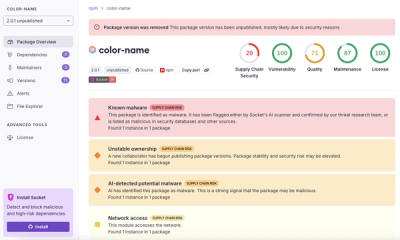
Research
/Security News
npm Author Qix Compromised via Phishing Email in Major Supply Chain Attack
npm author Qix’s account was compromised, with malicious versions of popular packages like chalk-template, color-convert, and strip-ansi published.
jpkleemans-angular-validate
Advanced tools
Painless form validation for AngularJS. Powered by the jQuery Validation Plugin.
Download Angular Validate:
$ npm install jpkleemans-angular-validate
$ bower install jpkleemans-angular-validate
$ git clone https://github.com/jpkleemans/angular-validate.git
When using one of the last two methods make sure you also download the latest release of the jQuery Validation Plugin.
Include both jquery.validate.min.js and angular-validate.min.js in your HTML page:
<!-- jQuery scripts -->
<script src="path/to/jquery.min.js"></script>
<script src="path/to/jquery.validate.min.js"></script>
<!-- Angular scripts -->
<script src="path/to/angular.min.js"></script>
<script src="path/to/angular-validate.min.js"></script>
Inject the ngValidate module as a dependency into your Angular application:
angular.module('myApp', ['ngValidate']);
Add the ng-validate directive to your form and pass the validation options as value:
<form name="registerform" ng-submit="register(registerform)" ng-validate="validationOptions">
<input type="email" name="email">
<input type="password" name="password">
</form>
Then set the validation options in your controller:
$scope.validationOptions = {
rules: {
email: {
required: true,
email: true
},
password: {
required: true,
minlength: 6
}
},
messages: {
email: {
required: "We need your email address to contact you",
email: "Your email address must be in the format of name@domain.com"
},
password: {
required: "You must enter a password",
minlength: "Your password must have a minimum length of 6 characters"
}
}
}
Or (for simple forms) insert the options directly without using a controller:
<form name="simpleform" ng-submit="register(simpleform)" ng-validate="{rules: {name: "required"}}">
For all available options, see: http://jqueryvalidation.org/validate#validate-options
Now you can validate the form by calling validate() on the form instance:
$scope.register = function (form) {
if(form.validate()) {
// Form is valid!
}
}
You can also pass your validation options as the first parameter of
validate().
$window.alert("There are " + form.numberOfInvalids() + " invalid fields.");
A set of standard validation rules is provided by the jQuery Validation Plugin:
More info: http://jqueryvalidation.org/documentation/#link-list-of-built-in-validation-methods
Angular Validate ships with a $validatorProvider, that you can use to configure default validation options and custom validation rules.
angular.module('myApp')
.config(function ($validatorProvider) {
$validatorProvider.setDefaults({
errorElement: 'span',
errorClass: 'help-block'
});
});
More info: http://jqueryvalidation.org/jQuery.validator.setDefaults
angular.module('myApp')
.config(function ($validatorProvider) {
$validatorProvider.addMethod("domain", function (value, element) {
return this.optional(element) || /^http:\/\/mydomain.com/.test(value);
}, "Please specify the correct domain for your documents");
});
More info: http://jqueryvalidation.org/jQuery.validator.addMethod
angular.module('myApp')
.config(function ($validatorProvider) {
$validatorProvider.setDefaultMessages({
required: "This field is required.",
remote: "Please fix this field.",
email: "Please enter a valid email address.",
url: "Please enter a valid URL.",
date: "Please enter a valid date.",
dateISO: "Please enter a valid date (ISO).",
number: "Please enter a valid number.",
digits: "Please enter only digits.",
creditcard: "Please enter a valid credit card number.",
equalTo: "Please enter the same value again.",
accept: "Please enter a value with a valid extension.",
maxlength: $validatorProvider.format("Please enter no more than {0} characters."),
minlength: $validatorProvider.format("Please enter at least {0} characters."),
rangelength: $validatorProvider.format("Please enter a value between {0} and {1} characters long."),
range: $validatorProvider.format("Please enter a value between {0} and {1}."),
max: $validatorProvider.format("Please enter a value less than or equal to {0}."),
min: $validatorProvider.format("Please enter a value greater than or equal to {0}.")
});
});
More info: http://jqueryvalidation.org/jQuery.validator.format
FAQs
"jQuery validator plugin for angularjs"
The npm package jpkleemans-angular-validate receives a total of 31 weekly downloads. As such, jpkleemans-angular-validate popularity was classified as not popular.
We found that jpkleemans-angular-validate demonstrated a not healthy version release cadence and project activity because the last version was released a year ago. It has 1 open source maintainer collaborating on the project.
Did you know?

Socket for GitHub automatically highlights issues in each pull request and monitors the health of all your open source dependencies. Discover the contents of your packages and block harmful activity before you install or update your dependencies.

Research
/Security News
npm author Qix’s account was compromised, with malicious versions of popular packages like chalk-template, color-convert, and strip-ansi published.

Research
Four npm packages disguised as cryptographic tools steal developer credentials and send them to attacker-controlled Telegram infrastructure.

Security News
Ruby maintainers from Bundler and rbenv teams are building rv to bring Python uv's speed and unified tooling approach to Ruby development.